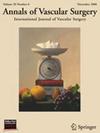Calf Muscle-Venous Pump Dysfunction in Patients with Pelvic Venous Disorder
IF 1.4
4区 医学
Q3 PERIPHERAL VASCULAR DISEASE
引用次数: 0
Abstract
Background
To study the evacuation function of calf muscle-venous pump (CMP) in patients with pelvic venous disorder (PeVD).
Methods
This single-center cross-sectional study included 170 female patients (120 with PeVD ± chronic venous disease (CVD) and 50 with CVD without PeVD) and 20 healthy volunteers. All subjects underwent duplex ultrasound (DUS) of the pelvic and lower extremity veins, radionuclide venography (RV) of the lower extremities, and single-photon emission computed tomography (SPECT) of the pelvic veins (PVs) with in vivo labeled red blood cells (RBCs). The pelvic venous congestion (PVC) signs were deposition of labeled RBCs in the PVs and the PVC coefficient (CPVC) > 0.5. The CMP evacuation dysfunction was identified during RV as an increase in the average isotope transit time (Tave) in the tendon (Tt) and muscle (Tm) parts of CMP and in the popliteal vein (Tpv).
Results
The CMP dysfunction was detected in 81.6% and 78.3% of patients with symptomatic and asymptomatic PeVD, accordingly, and in 92% of patients with CVD. This condition was characterized by a significant increase in the isotope transit time (Tt 18–30 s, Tm 27–45 s, and Tpv 20–40 s).
Conclusion
The CMP dysfunction is present in about 80% of patients with PeVD, regardless of the clinical course of PeVD and the presence of CVD of the lower extremities.
求助全文
约1分钟内获得全文
求助全文
来源期刊
CiteScore
3.00
自引率
13.30%
发文量
603
审稿时长
50 days
期刊介绍:
Annals of Vascular Surgery, published eight times a year, invites original manuscripts reporting clinical and experimental work in vascular surgery for peer review. Articles may be submitted for the following sections of the journal:
Clinical Research (reports of clinical series, new drug or medical device trials)
Basic Science Research (new investigations, experimental work)
Case Reports (reports on a limited series of patients)
General Reviews (scholarly review of the existing literature on a relevant topic)
Developments in Endovascular and Endoscopic Surgery
Selected Techniques (technical maneuvers)
Historical Notes (interesting vignettes from the early days of vascular surgery)
Editorials/Correspondence

 求助内容:
求助内容: 应助结果提醒方式:
应助结果提醒方式:


